|
|
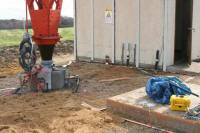
|
|
|
|
One of the tower bases at KRLD. There were numerous abandoned
concrete slaps scattered around the site. These slabs have been used
for various equipment and antenna feed systems. |
|
|
|
|
|
|
|
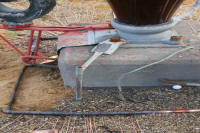
|
|
|
|
Each tower, building and slab was encircled with 1in copper pipe such
that the radials could be continued with minimal disturbance. We
removed some of the concrete but found that many of the slabs were
either very large or had conduits running thru them. |
|
|
|
|
|
|
|
|
|
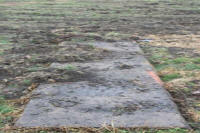
|
|
|
|
One of the less intrusive slabs. This particular slab had been the
mounting point for an experimental slant feed many years ago. It was
almost at grade level so we simply plowed up to and over it. Later a
layer of soil was packed over the exposed concrete and radials. |
|
|
|
|
|
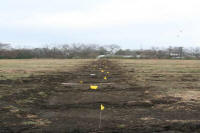
|
|
|
|
The transverse ditch. A 4in copper strap will eventually be dropped into this shallow ditch for transverse bonding. |
|
|
|
|
|
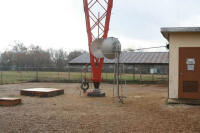
|
|
|
|
Tower base near the TX building. Note the STL isocoupler. It is a very high voltage design. |
|
|
|
|
|
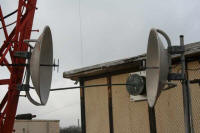
|
|
|
|
In case you didn't see the STL isocoupler in the previous image...
It is 2 solid dishes carefully aimed at each other from abt 6ft apart.
Loss across this arrangement is
surprisingly low. |
|
|
|
|
|
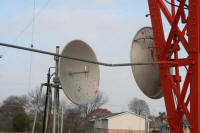
|
|
|
|
The line/pipe horizontal across the center of the image is the RF feed to the tower. |
|
|
|
|
|
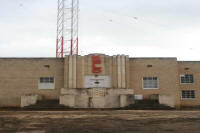
|
|
|
|
The front of the KRLD TX building. Obviously built when the transmitter was not just another expense... |
|
|
|
|
|
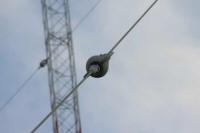
|
|
|
|
One of the guy anchors. This thing is a cast iron framework holding an insulator larger than most normal base insulators. |
|
|
|
|
|

|
|
|
|
One of the fence posts after grounding. A #6 copper wire was brazed
to the post about 8 inches above natural grade level. The heat of
brazing destroys the galvanization and requires several coats of cold
galv for repair. Then the damaged area was coated with roofing tar for
waterproofing. |
|
|
|
|
|
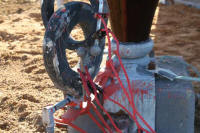
|
|
|
|
Grounding the unused tower with jumper cables. With 50kw ND on the
other tower, the unused tower was HOTTTT! A nice 2in arc was evidence
of that when connecting the safety short. |
|
|
|
|
|
|
|
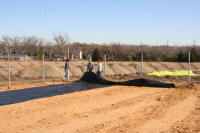
|
|
|
|
Fabric and gravel going down. |
|
|
|
|
|
|
|
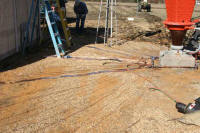
|
|
|
|
Another angle of the tower base. |
|
|
|
|
|
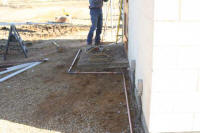
|
|
|
|
The copper pipe around one of the ATU buildings. |
|
|
|
|
|

|
|
|
|
Copper pipe, radials and strap around a tower base. |
|
|
|
|
|
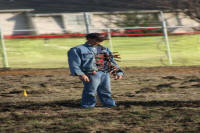
|
|
|
|
Dave... One of the temps. A good guy but only had 2 speeds. Slow
and slower. Here he has dozens of clamps clipped onto his jacket. |
|
|
|
|
|
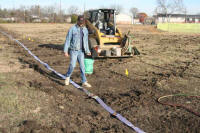
|
|
|
|
Dave actually using the clamp bucket. |
|
|
|
|
|
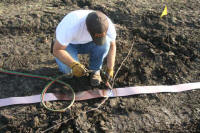
|
|
|
|
Tad brazing radials to the transverse strap. |
|
|
|
|
|
|
|
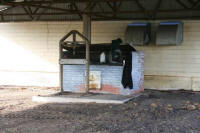
|
|
|
|
I think that there is an FCC rule somewhere whereas "every
transmitter site shall have a BBQ grill". In typical Texas style, this
is KRLD's. |
|
|
|
|
|
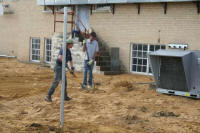
|
|
|
|
Spreading gravel at the back of the transmitter building. |
|
|
|
|
|
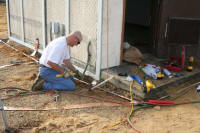
|
|
|
|
Jeremy brazing radials to an ATU building ground ring. |
|
|
|
|
|
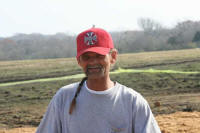
|
|
|
|
Jimmy... Another of the temps. Jimmy has been everywhere and done everything. Some of it a couple of times I would guess. |
|
|
|
|
|
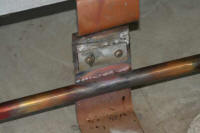
|
|
|
|
One bonding point inside the ATU building. The strap running
vertically was original and the horizontal pipe was installed by AGSC
per Selemeyer specs. |
|
|
|
|
|
|
|
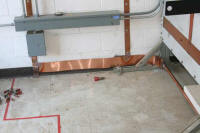
|
|
|
|
Strap installed to bond everything together. We could not verify
that there was a single point where all grounds were common. Now we
can... The red line in the bottom left hand corner is the safety line.
Over that line, the RF radiation is above occupational maximum when
KRLD is ND at 50kw. |
|
|
|
|
|
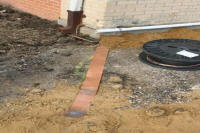
|
|
|
|
One of the newly installed ground rods with connecting strap. This one at one of the TX building corners. |
|
|
|
|
|
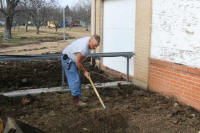
|
|
|
|
Tracy doing the temps job. The temps sometimes spent more time talking and resting than working. |
|
|
|
|
|
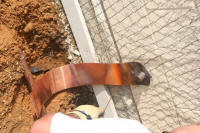
|
|
|
|
A ground strap from the copper pipe running thru an ATU building down
to the radial connection pipe. Note the screen on the ATU building
wall. Station engineers were not sure if the screen was for RF
radiation protection or RF isolation
from he tuning network inside the building. |
|
|
|
|
|

|
|
|
|
A tower base showing some of the copper work required to insure that all things ground are firmly grounded. |
|
|
|
|
|

